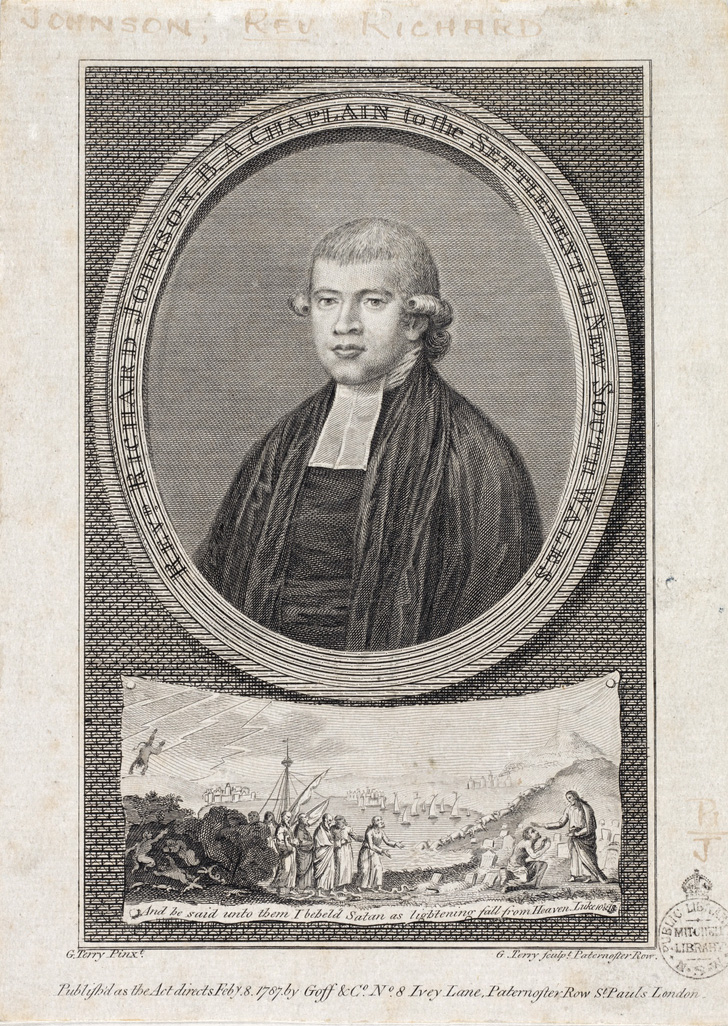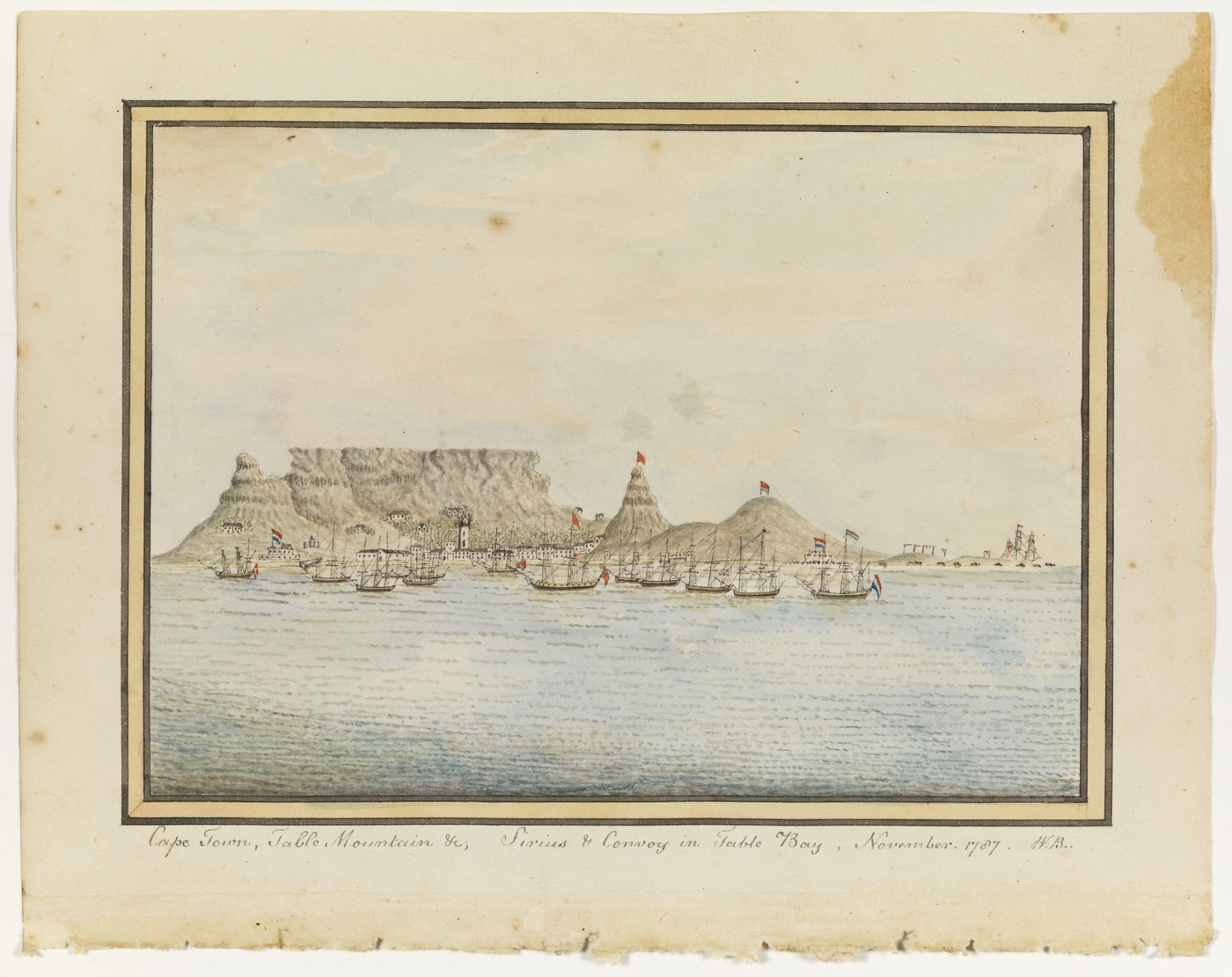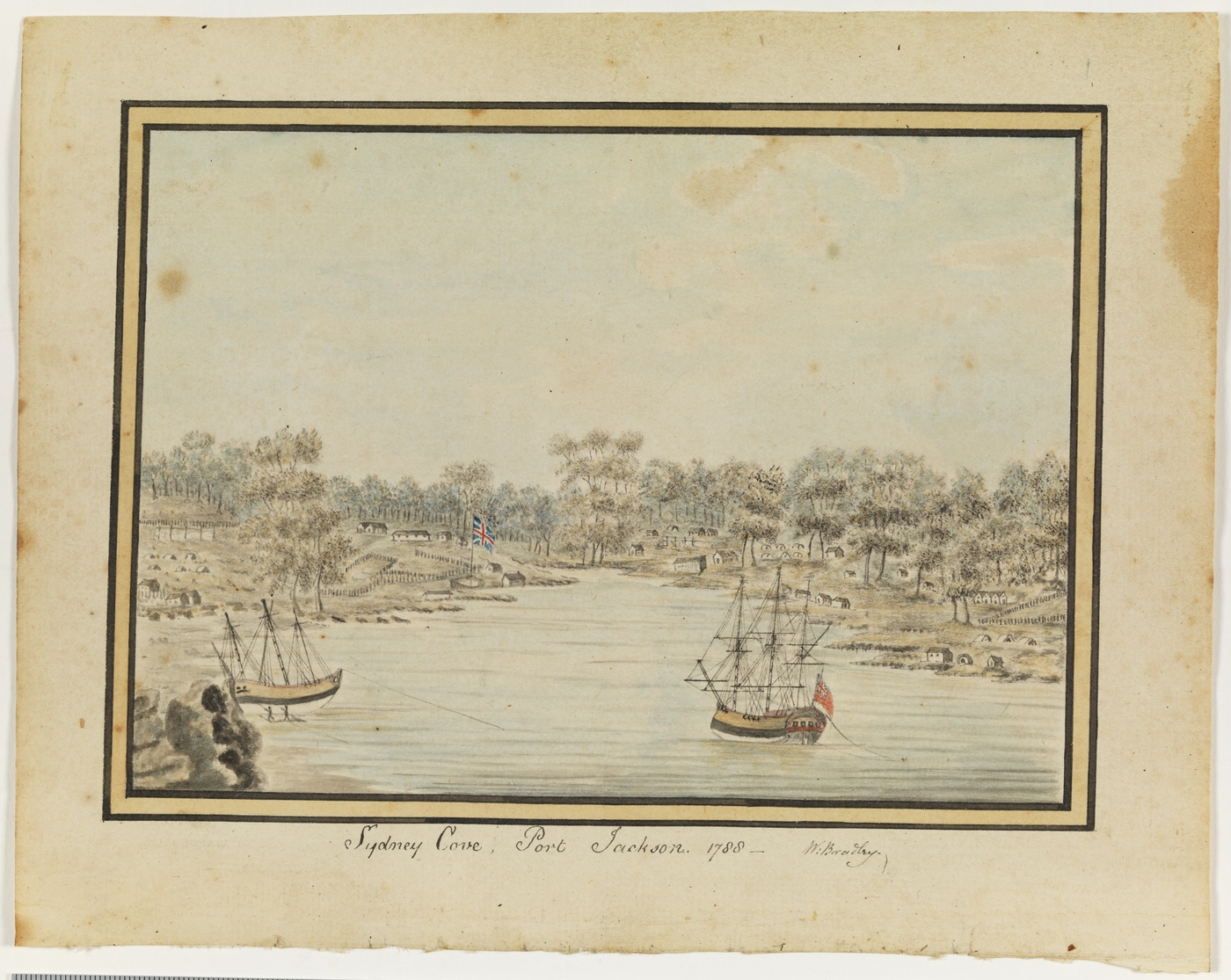The Dictionary of Sydney was archived in 2021.
Golden Grove
Citation
Persistent URL for this entry
To cite this entry in text
To cite this entry in a Wikipedia footnote citation
To cite this entry as a Wikipedia External link
Golden Grove
The 331-ton Golden Grove was built in 1780 in Whitby, the coastal North Yorkshire town whose prominent shipbuilding industry had produced Cook 's Endeavour 16 years before. Along with Borrowdale and Fishburn, Golden Grove was one of the three storeships of the First Fleet, all owned by William Leighton & Co, and employed in the coal trade. [1]
Golden Grove departed Portsmouth, England, on 13 May 1787 under the command of William Sharp, and with a crew of 20. [2] Among the passengers for the voyage to Australia were Reverend Richard Johnson, his wife Mary and Johnson's servant Samuel Barnes. In October 1786 Johnson had been officially appointed as chaplain to the new colony, a grand task for the scholarly Johnson. [3] [media]During his time at sea, Johnson baptised children and held services, expressing in letters home his hopes for the improvement of the moral state of the crew and convicts:
Accordingly, last Sunday I preached to them [the crew] – my text was in Matt: 5:34 – designed to set forth the heinous evil of common swearing…Since then I have scarcely heard an oath from any of them. [4]
During the voyage Golden Grove experienced a number of mishaps, including breaking her fore topgallant mast no fewer than three times. [5] During stops at Tenerife, Rio de Janeiro and Cape Town, a variety of livestock was purchased and loaded, both for the public use of the future colony and for the private use of the officers, many of whom planned to establish their own farms in the new land:
In the course of a month, the lives stock and other provisions were procured; and the ships, having on board not less than five hundred animals of different kinds, but chiefly poultry, put on an appearance which naturally excited the idea of Noah's Ark. [6]
[media]The First Fleet departed Cape Town on 12 November for the last and longest leg of its voyage. Phillip decided to split the fleet and sailed ahead with the four fastest ships to make preparations for the arrival of the bulk of the transports. John Hunter, captain of the naval escort HMS Sirius, was left in charge of the slower division, which included Golden Grove and the other two storeships Fishburn and Borrowdale, as well as the transports Charlotte, Lady Penrhyn and Prince of Wales. [7]
[media]Along with the rest of the fleet, Golden Grove anchored in Sydney Cove on 26 January 1788.
In early September, Phillip ordered Golden Grove to Norfolk Island to deliver 18 months' worth of provisions for the small number of marines, convicts and free men who had been settled there under the command of Lieutenant King. Golden Grove also brought another 41 residents to the island, including 21 male and 11 female convicts. After an absence of five weeks, the vessel returned to Sydney on 10 November 1788 with news from the island and new masts for herself and Fishburn. [8]
Return voyage
Golden Grove embarked upon her return journey to England in company with Fishburn on 19 November 1788, leaving only the naval escort HMS Supply at the disposal of the fledgling colony. The second naval ship HMS Sirius had left in October for the Cape of Good Hope to purchase supplies, and the six transports and third storeship, Borrowdale, had left in two groups, one in May, the other in July.
Ignoring Governor Phillip's recommendation to avoid the route, the two ships sailed around Cape Horn to Rio de Janeiro. They stopped in the Falkland Islands in mid-January for provisions and remained there for several weeks in order to take on fresh food and for stricken crew to recover from scurvy. After a journey of six months, Golden Grove landed her dispatches at Cork in Ireland on 16 May and arrived at Deptford on 9 June 1789. [9] Along with Fishburn, Golden Grove is credited as having made the fastest return journey of any of the First Fleet ships. [10]
After returning to England, Golden Grove was employed for several years in hauling coal from Newcastle under the command of William Sharp before undertaking a voyage to the Continent in 1791–92. She was re-registered in Liverpool in 1804, but then disappeared from the record and her fate is unknown. [11]
References
Bateson, Charles. The Convict Ships, 1787–1868. Glasgow: Brown, Son & Ferguson, 1969.
Cavanagh, AK. 'The Return of the First Fleet Ships'. Victoria: Australian Association for Maritime History, 1989.
Collins, David. An Account of the English Colony in New South Wales. Sydney: AH and AW Reed, 1975.
Fidlon, Paul and RJ Ryan, eds. The First Fleeters: A Comprehensive Listing of Convicts, Marines, Seamen, Officers, Wives, Children, aAnd Ships. Sydney: Australian Documents Library, 1981.
Gillen, Mollie. The Founders of Australia: A Biographical Dictionary of The First Fleet. Sydney: Library of Australian History, 1989.
Lloyd's Register. Lloyd's Register of Shipping 1760–1900. London: Gregg Press, 1963.
Johnson, Richard. Letters from the Rev Richard Johnson to Henry Fricker, State Library of NSW, 1787–1797, MLMSS Safe 1/21.
King, Jonathan. The First Fleet: The Convict Voyage that Founded Australia 1787–88. Melbourne: Macmillan, 1982.
King, PG. Journal of Philip Gidley King, 1787–1790: Lieutenant, R. N. 1787–1790. University of Sydney Library, Australian Digital Collections / First Fleet and Early Settlement, http://purl.library.usyd.edu.au/setis/id/kinjour
Mundle, Rob. The First Fleet. Sydney: Harper Collins, 2014.
Phillip, Arthur. The Voyage of Governor Phillip to Botany Bay. London: John Stockdale, 1789. University of Sydney Library, Australian Digital Collections / First Fleet and Early Settlement, http://purl.library.usyd.edu.au/setis/id/phivoya
White, HR. A First Fleet Index. Southport, Qld: South Coast Bulletin, 1960.
Notes
[1] Charles Bateson, The Convict Ships, 1787–1868 (Glasgow: Brown, Son & Ferguson, 1969), 95
[2] Mollie Gillen, The Founders of Australia: A Biographical Dictionary of the First Fleet (Sydney: Library of Australian History, 1989), 429
[3] Mollie Gillen, The Founders of Australia: A Biographical Dictionary of the First Fleet (Sydney: Library of Australian History, 1989), 195
[4] Richard Johnson, Letter 1, 30 May 1787, Letters from the Rev Richard Johnson to Henry Fricker, State Library of NSW, 1787–1797, MLMSS Safe 1/21
[5] Jonathan King, The First Fleet: The Convict Voyage that Founded Australia 1787–88 (Melbourne: Macmillan, 1982), 20
[6] 'Golden Grove', First Fleet Fellowship website, http://firstfleetfellowship.org.au/ships/golden-grove/, viewed 9 January 2015
[7] 'Golden Grove', First Fleet Fellowship website, http://firstfleetfellowship.org.au/ships/golden-grove/, viewed 9 January 2015
[8] 'Golden Grove', First Fleet Fellowship website, http://firstfleetfellowship.org.au/ships/golden-grove/, viewed 9 January 2015
[9] Mollie Gillen, The founders of Australia: a biographical dictionary of the First Fleet (Sydney: Library of Australian History, 1989), 429
[10] AK Cavanagh, The Return of the First Fleet Ships (Victoria: Australian Association for Maritime History, 1989), 6
[11] Jonathan King, The First Fleet: The Convict Voyage that Founded Australia 1787–88 (Melbourne: Macmillan, 1982), 20





